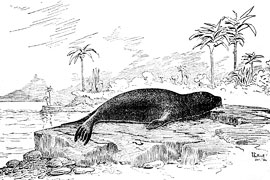

 |
||
 |
||
Vol. 11 (1): June 2008 |
||
Review concludes Caribbean monk seal is extinctA just-published U.S. status review has concluded that the Caribbean monk seal is extinct, and that sightings reports that have generated much intrigue and hope in recent decades are likely to have been of other species than Monachus tropicalis. In this issue of Monachus Science, the Guardian is publishing an article based on that 5-year review, by Kyle Baker, Fishery Biologist at NOAA/NMFS: So many seals, so little time: The rapid extinction of the Caribbean monk seal. The US Marine Mammal Commission has endorsed the review’s conclusion, adding that it “recommends, with regret, that the National Marine Fisheries Service proceed with steps to remove the Caribbean monk seal from the Endangered Species Act’s List of Endangered and Threatened Wildlife on grounds that the species is now extinct.” NMFS is currently preparing to publish a proposed federal rule to that end. Further informationNMFS. 2008. Endangered Species Act 5-Year Review for the Caribbean Monk Seal (Monachus tropicalis). National Marine Fisheries Service Southeast Regional Office, St. Petersburg, Florida, March 7, 2008: 1-20. [PDF Marine Mammal Commission. 2008. The biological viability of the most endangered marine mammals and the cost-effectiveness of protection programs. The Marine Mammal Commission’s Report to Congress, February 2008: 1-448. [PDF
|
 |
|
|
|
Historical records from the 17th and 18th century show there were huge numbers of monk seals, distributed among 13 colonies across the Caribbean.
They were so plentiful that some ships’ maps of the West Indies even noted particularly dense locations of seals.
Alas for Monachus tropicalis, colonisation of the West Indies unleashed unbridled hunting, the bounty being seal oil that was used to grease machinery in sugar plantations.
Towards the end of the 19th century, the seals were reduced to a final redoubt of a few atolls — and their worst enemy became natural history museums and private collectors keen for monk seal skeletons.
In one disastrous episode, a 1911 expedition to Mexico by natural-history enthusiasts killed 200 seals, leaving just a handful alive, and driving the depleted population further towards extinction.
In a study published on Wednesday in the British journal Proceedings of the Royal Society B, oceanographers Loren McClenachan and Andrew Cooper perform a heroic act of biostatistics in recreating the life and sad demise of the seal.
They calculate that, before the massacre, between 233,000 and 338,000 monk seals lived in the Caribbean. Such a huge population could only survive, of course, provided there was a huge supply of food.
At a rough estimate, each adult seal would eat 245 kilos (539 pounds) of fish per year, and a juvenile seal 50 kilos, say McClenachan and Cooper.
“The biomass of free fish required to sustained the estimated population of historical monk seals is four to six times greater than the average Caribbean reef, which exceeds that found on the most pristine Caribbean coral reef today and is in the same range of the most pristine reefs” in the remote Pacific, their paper says.
The study gives a crucial pointer about the pace of degradation of Caribbean coral reefs, where the biggest problem has been overfishing.
“Realistic construction of these past ecosystems is critical to understanding the profound and long-lasting effect of human hunting on the functioning of coral reef systems,” they write.
Extinction of the monk seal also had a huge knock-on effect across the Caribbean’s food web. Removal of a major predator allowed some species of fish to expand at the expense of others, eventually transforming the picture of biodiversity.
– Caribbean Net News, 19 March 2008, Extinct seal tells of once-teeming Caribbean reefs.
McClenachan, Loren and Andrew B. Cooper. Extinction rate, historical population structure and ecological role of the Caribbean monk seal. 2008. Proceedings of The Royal Society B – Biological Sciences: 1-8. [Abstract]
Copyright © 2008 The Monachus Guardian. All Rights Reserved |